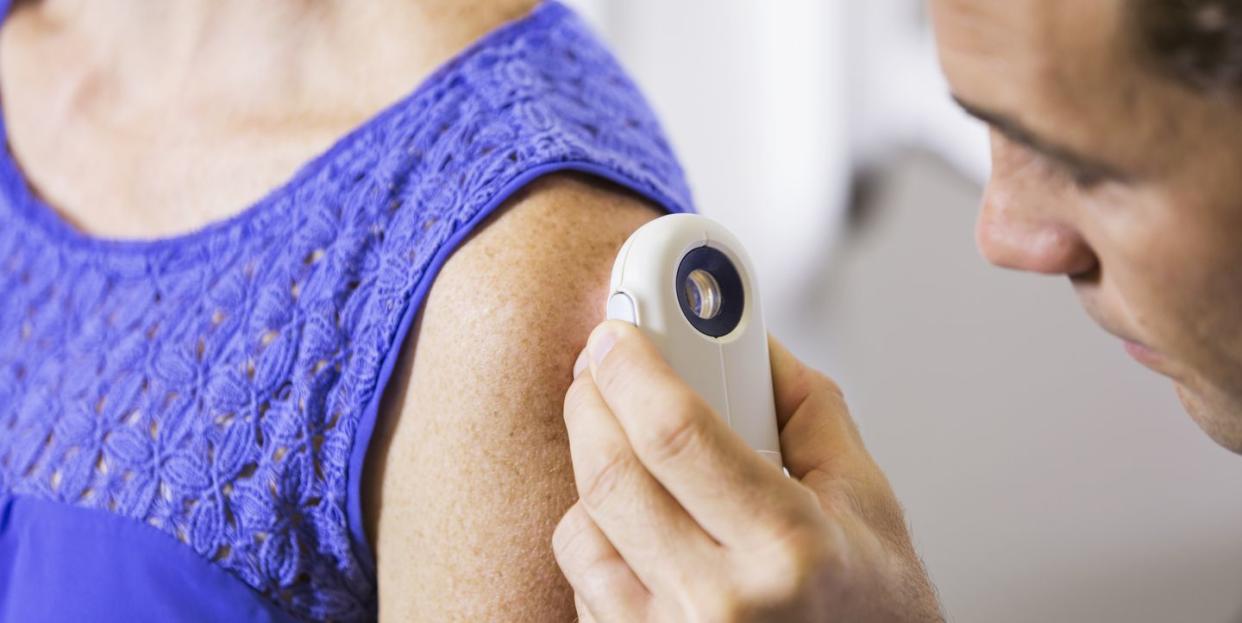Could Artificial Intelligence Diagnose Skin Cancer?

"Hearst Magazines and Yahoo may earn commission or revenue on some items through the links below."
Artificial intelligence sounds futuristic, but it’s already all around us (yes, talking about you, Alexa). It powers a variety of sometimes-amazing, sometimes-annoying aspects of everyday life, like autofill and Amazon product recommendations. It’s also a burgeoning area in health care—so what does that mean for your life?
How AI can be used in health care
Here’s an example of how AI works to make time-consuming tasks simpler for people: In radiology, physicians are trained to analyze x-rays, CT scans, and other images for abnormalities; this requires individual study of hundreds of thousands of images to become familiar with what’s normal and what’s not. Computers can now be used to translate an image into data, compare that data against a larger data set comprised of both normal and abnormal images, and produce a quantitative assessment of potential abnormalities. Recent studies have shown that some AI algorithms perform as well as radiologists in analyzing mammograms for breast cancer, and when used by radiologists as an aid, they can enhance diagnostic accuracy.
In dermatology, another specialty that relies on image recognition, there is similar enthusiasm for the use of AI in diagnosing serious skin conditions, including cancer. Melanoma is the fifth most common invasive cancer in the US, and it is the leading cause of death from skin cancer. Early detection is crucial, and most lesions are identified when a dermatologist performs a total body skin examination as a screening test. One study showed that a computer algorithm that had been trained with a data set of almost 130,000 images successfully distinguished malignant melanoma from benign lesions with accuracy comparable to a human dermatologist.
Researchers are also interested in classifying non-melanoma skin cancers, such as basal cell carcinoma and squamous cell carcinoma. This is a challenging task, as there is a much broader set of diagnoses that must be ruled out, including other benign and malignant neoplasms, cysts, and inflammatory skin diseases. One study found that a computer algorithm classified common skin cancers more accurately than humans but was less accurate in identifying rare skin cancers. This limitation in function was likely because the algorithm was trained on few images of rare cancers. In this respect, computers are not so different from humans; if they haven’t “seen” a specific condition in the past, they will not be very good at identifying it in the future.
Will a computer diagnose you?
Experts are not yet ready to advocate for the widespread use of AI. Most studies have been retrospective or performed in theoretical settings under optimal conditions. Additional research needs to define how and when AI should be used in the real world, as the consequences of a false positive or false negative test result are serious. In the case of skin cancer, where the tech is most advanced, a false positive result could require unnecessary, expensive, and stressful follow-up testing, such as a biopsy, to rule out the diagnosis, and a false negative result would, of course, allow a cancer to progress unchecked. Until computer algorithms have reliably low error rates that are reproducible in different settings, clinicians are unlikely to be willing to risk a poor patient outcome.
In addition, AI can sometimes perpetuate biases and systemic racism that is found in the data on which algorithms are trained. In one highly publicized case, an algorithm used by hospitals and insurance companies to predict those patients who would benefit from additional medical care significantly underestimated the needs of black patients due to reliance on past health care expenditures as an input; since black patients use less health care on average, the result was that healthier white patients were more often flagged as needing intensive care management, even though race was not explicitly used as a variable in the algorithm. Unfortunately, researchers failed to recognize historical inequities in health care and created a tool that unintentionally exacerbated racial health disparities. In dermatology, if algorithms are trained on data sets that mostly contain images of lighter-skinned individuals, they may not be reliable when evaluating patients with darker skin. Minority groups are traditionally underrepresented in research studies, and greater efforts need to be made to ensure that diagnostic tests and treatments are evaluated in and are relevant to diverse patient populations.
Right now, AI holds tremendous promise in specific areas, like improving the analysis of skin lesions, since that requires an objective approach that is less subject to variability in interpretation between individuals. However, it is most likely that computer algorithms will augment, not replace, humans for diagnosis of cancer. Humans are still better at synthesizing other important pieces of information, such as a patient’s other health conditions, family history, and change in condition over time. Plus, you can’t discount the pure science-fiction-ness of it all: Physicians and patients just don’t have confidence in it yet—but as the technology improves and becomes more inclusive, we may become as accustomed to AI in the doctor’s office as we are with it serving us up ads for the last thing we searched for.
You Might Also Like

